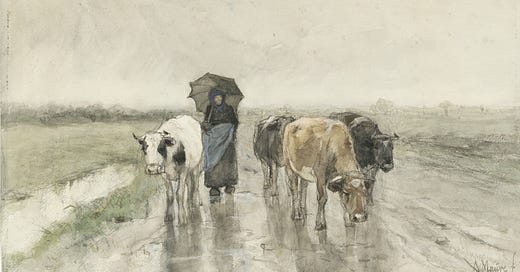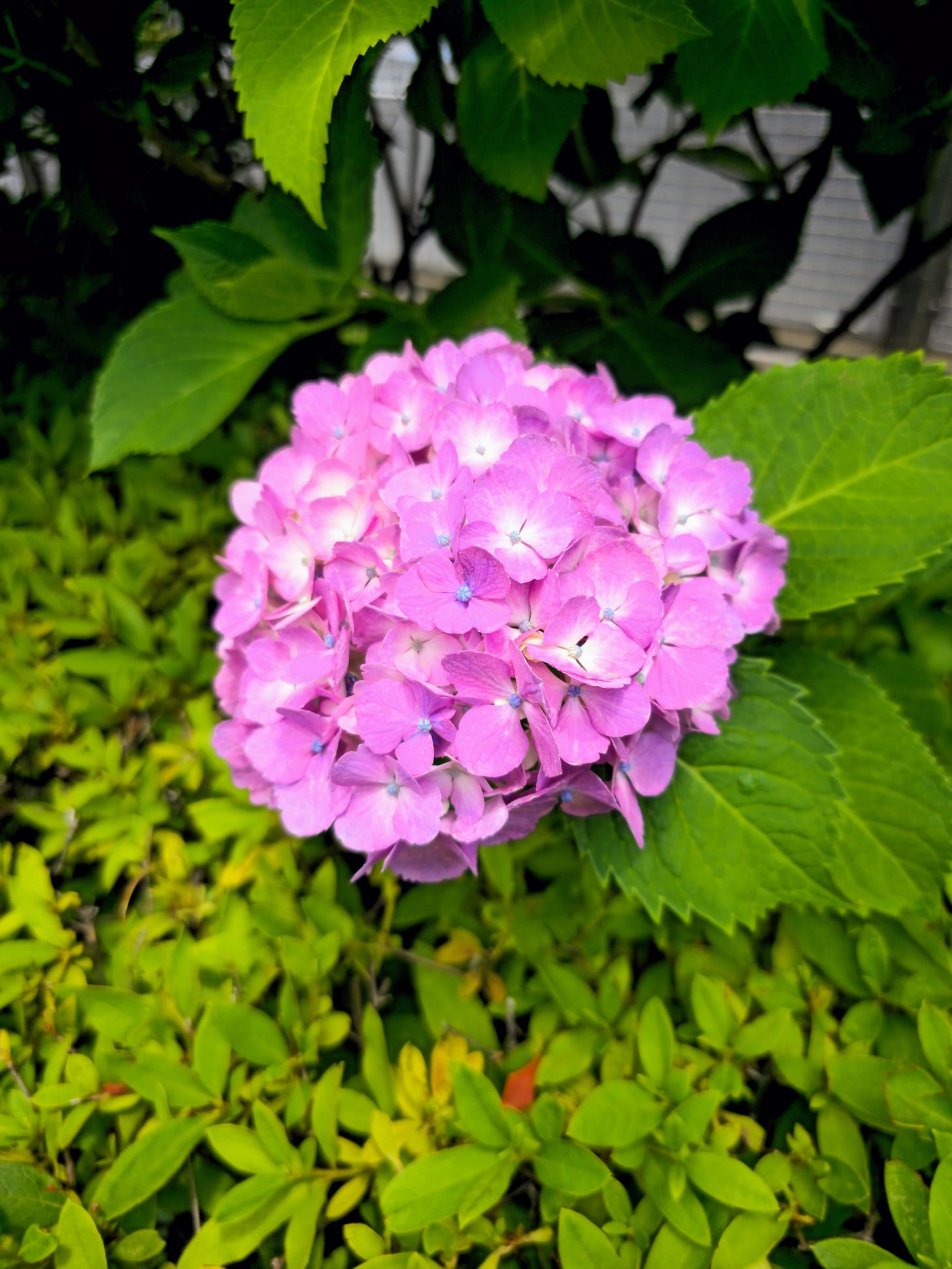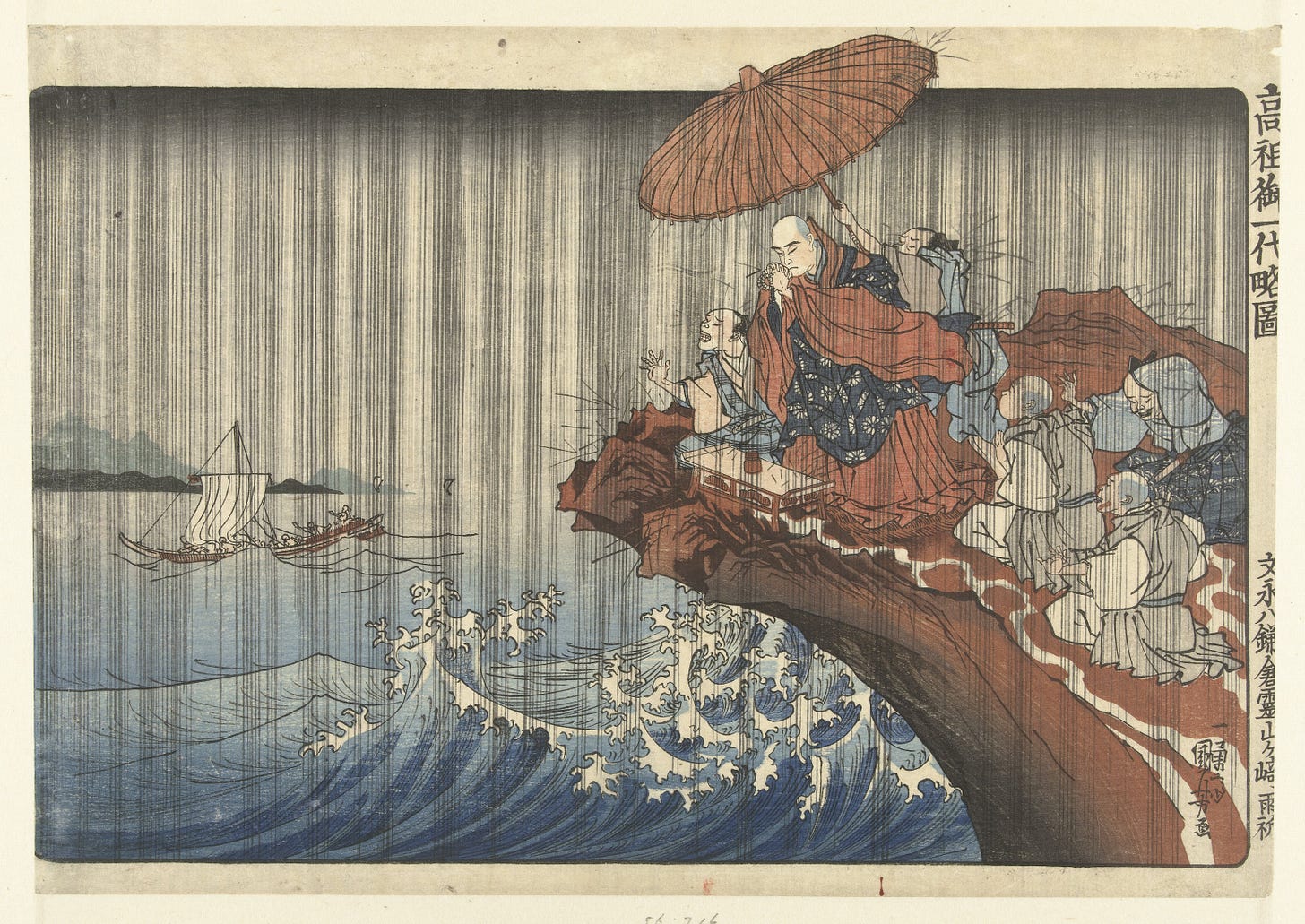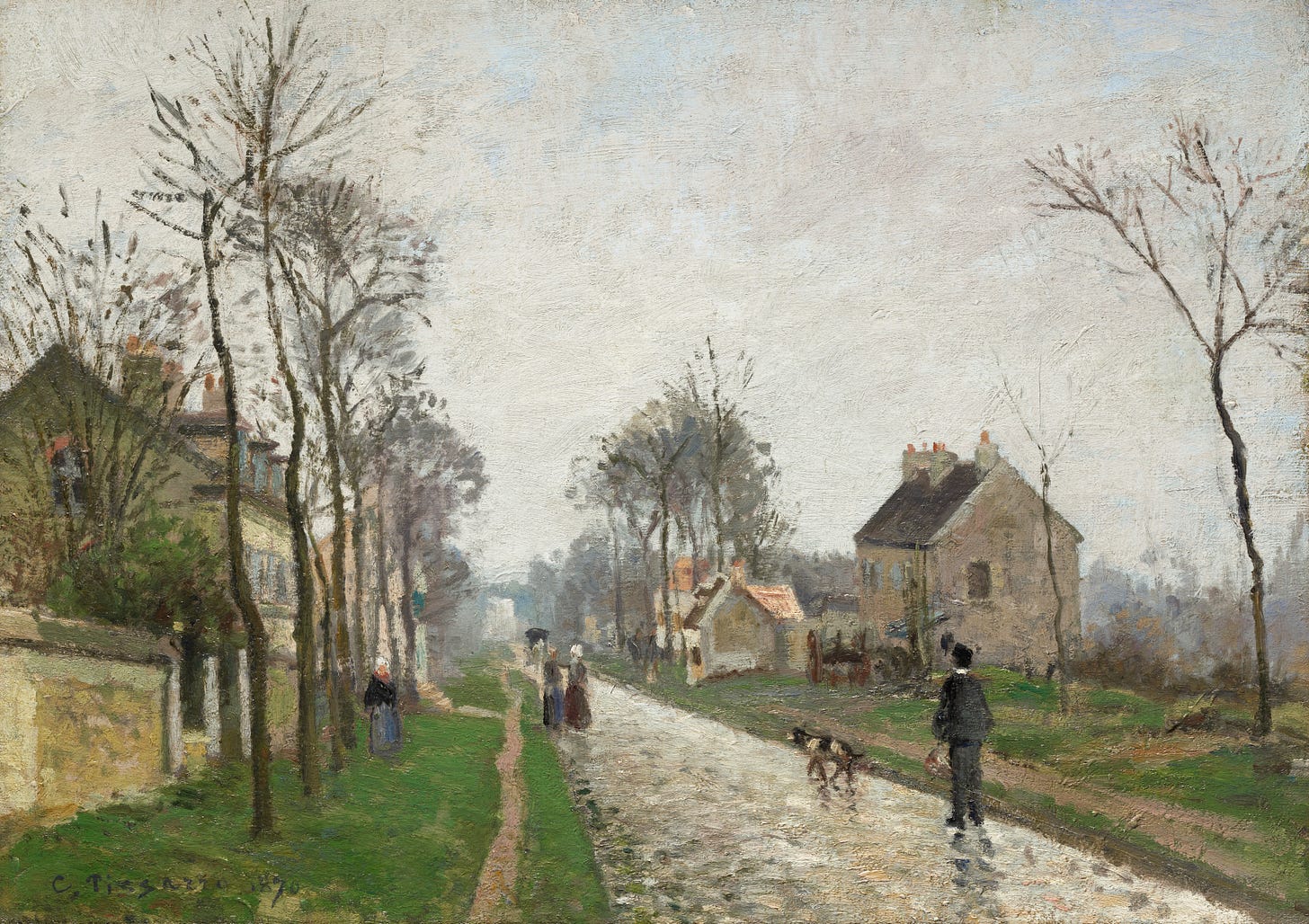The month of the drowned dog. After long rain the land
Was sodden as the bed of an ancient lake,
Treed with iron and bird less.
From November, by Ted Hughes
🌧️🌧️🌧️🌧️🌧️🌧️
One of the questions about England I’d sometimes get asked in my former job was, “when is the rainy season?” This tended to provoke a less than professional guffaw from me before I’d dutifully explain that where I grew up, in Devon, it would rain—a little or a lot—at any time of year. The idea of a rainy season would have seemed absurd to my childhood self, raised through wet summers and damp autumns. But the question was understandable. If you grow up in a place where there are distinct wet and dry seasons, it’s hard not to imagine that the rest of the world is like that. The same applies, in reverse, to someone like me from a place where there’s no distinct wet season. When it’s always, potentially, a wet season. So experiencing the reality of true rainy seasons has been a really interesting part of living in other countries for me.
🌧️🌧️🌧️🌧️🌧️🌧️
And the the rainy season is approaching here in Japan. As is the case in China, June is the time for the plum rains, the 梅雨 (pronounced “méiyǔ” in Chinese, “tsuyu” in Japanese). The increased rainfall coincides with the plum harvest season. Here in Japan, plum wine and pickled plums will be produced. You can buy DIY kits in shops to make them yourselves or purchase the finished product. At one of my local parks, where I enjoyed the beautiful plum blossoms in February, the ground is now covered by yellowed plums. In Shanghai, the plum rains are also called 黄梅 天 ( “huángméi tiān” or “yellow plum weather”) or 霉天 (“méi tiān” or “mould (mold) weather”. This is the “rainy season of the yellow mould” (the words plum and mould are pronounced the same in Chinese).
My image of the plum rain is of a fine, insistent drizzle, which I recall from my time in Shanghai, sometimes goes by the delightful Chinese name of 毛毛雨 (“máo máo yǔ”; 毛/”máo” means “hair” or “feather”). In Japan, the plum rains are heavily associated with hydrangeas, which are already blooming.
Appreciation of this season goes back a long way: the great Tang poet 杜甫, Du Fu (712–770), wrote wistfully and memorably about the plum rains:
梅雨
南京犀浦道,四月熟黃梅。
湛湛長江去,冥冥細雨來。
茅茨疏易溼,雲霧密難開。
竟日蛟龍喜,盤渦與岸迴。
Plum rain
At Xipudao in the Southern Capital city, April ripens the plums to gold.The mighty clear waters of the Yangtze flow on, and the darkening drizzles come down.
Thatched cottages easily yield to the rain, clouds and mist refuse to part.
Dragons rejoice all day long, whirlpools and eddies swirl around.
Translation by
and Jeffrey Streeter.1🌧️🌧️🌧️🌧️🌧️🌧️
My own first experience of a true rainy season was in Guayaquil, Ecuador. The dry season is the verano (summer), roughly May to November.2 During this summer period, there is a strong influence from the Humboldt Current that keeps the coastal plain around Guayaquil dry and relatively cool (especially on the coast, where fog is quite common). The heat builds in December and then the rains begin, which are often torrential. In my first year there, the rains caused severe flooding and parts of the city were inaccessible at times, including, briefly, my own barrio. The rain can be intense, almost biblical in intensity, alternating with periods of heat and humidity. I loved the sheer, insistent force of the rainy season and the brilliance of the skies when the clouds cleared. It was a season that created ever-changing moods.
Around that time, I came across Gabriel Garcia Marquez’s wonderful Monologue of Isabel watching it rain in Macondo. This was a kind of preliminary sketch for the author’s brilliant creation of Macondo in One Hundred Years of Solitude. In this monologue, the rain becomes more than simply a force of nature.
Llovió durante toda la tarde en un solo tono. En la intensidad uniforme y apacible se oía caer el agua como cuando se viaja toda la tarde en un tren. Pero sin que lo advirtiéramos, la lluvia estaba penetrando demasiado hondo en nuestros sentidos.
It rained all afternoon in a single tone. In the even, peaceful intensity you could hear the water falling as when you travel all afternoon on a train. But without us noticing, the rain was penetrating too far into our senses
Llovió durante todo el lunes, como el domingo. Pero entonces parecía como si estuviera lloviendo de otro modo, porque algo distinto y amargo ocurría en mi corazón.
It rained all day Monday, just like Sunday. But then it seemed as if it were raining in a different way, because something distinct and bitter was happening in my heart.
Al atardecer del martes el agua apretaba y dolía como una mortajada en el corazón.
At dusk on Tuesday, the water pressed and ached like a shroud over the heart.3
🌧️🌧️🌧️🌧️🌧️🌧️
Another great description of heavy rain—or rather, its effects—is that by Jun'ichirō Tanizaki in his celebrated novel, “The Morioka Sisters.” The descriptions of the flood occupy dozens of pages in Book Two of the novel and it’s an important plot point, too. Here, the impact of the rain is less psychological than social, as a dramatic rescue from the floods of one of the sisters leads to her falling in love with her rescuer. As he is from a lower social class, this becomes a major issue within this class-obsessed family, one only resolved by the rescuer’s later death from illness.
There are also some great set-piece descriptions:
Even for a flood it was extraordinary: great waves rolled from Mt. Rokkõ one after another, breaking and roaring and sending up sheets of foam, as if in an enormous caldron. It seemed less a river than a black, boiling sea, with the mid-summer surf at its most violent.4
🌧️🌧️🌧️🌧️🌧️🌧️
In English literature, one of the most powerful descriptions of rain comes in George Eliot’s The Mill on the Floss (1860). Here, the flood that follows days of heavy rain is more than a plot point; it culminates and resolves the whole story (vague spoiler alert!). We are almost literally driven to the conclusion of the book by the rain. The phrase “driving rain” is repeated several times in the closing pages before the accelerating waters of the river take over and propel the plot to its watery end. It’s as thrilling as rain ever gets in a novel.
As I read this novel for the first time a few years ago, I was struck by this sentence: “It was past midnight, and the rain was beating heavily against the window.”5 This was partly because it was part of the ominous build-up to the novel’s conclusion. But the line stood out I recalled very similar words from Samuel Beckett’s Molloy (1955, in English):
“It is midnight. The rain is beating on the windows. 6
These words are then directly contradicted at the end of the novel (spoiler alert!):
“It was not midnight. It was not raining.” 7
Until I read The Mill on the Floss, I’d assumed Beckett was imitating or channelling the kind of atmosphere-building phrase that you might see in earlier 20th-century detective fiction. After all, this part of Molloy is centred on Moran, who’s some kind of investigator. But Beckett’s sentence is uncannily close to Eliot’s. I somehow don’t think of Beckett as a reader of George Eliot. Perhaps the sentences came via other writers who were themselves consciously echoing Eliot. I hope one of you can help me out with some insights into this!
🌧️🌧️🌧️🌧️🌧️🌧️
To end, let me turn to Elizabeth Bishop and her short poem, Song for the Rainy Season. Bishop, who was familiar with rainy seasons from her 15 years in Brazil, is typically original in her treatment of the topic. She ends the poem by imagining the absence of rain:
Without water
the great rock will stare
unmagnetized, bare,
no longer wearing
rainbows or rain,
the forgiving air
and the high fog gone;
the owls will move on
and the several
waterfalls shrivel
in the steady sun.
It’s also a description of the transition to the dry season and captures that sense of normality and relief when the rainy season finally ends, felt by most people who have experienced it. I especially enjoy how Bishop sound-paints her ending, with the cascading cluster of “s” sounds that suggest the evanescence of rain: “the several/ waterfalls shrivel/in the steady sun.”
I’ll be travelling on holiday for the rest of June, but I’ve scheduled posts for the next three weeks. They’re from my early days on Substack, when I still had very few readers. As ever, I look forward to your comments, and I remain very grateful to you for reading English Republic of Letters.
I am hugely indebted for her help with this section, and not only for the bulk of the work in translating Du Fu’s poem, to our fabulous fellow Substacker
. Any errors are my own.I hope this is the first of many such collaborations. In the meantime, I would encourage you to check out her newsletter here:
Guayaquil is in the southern hemisphere, but I suppose that because some of the country, including the capital, Quito, is in the northern hemisphere, the northern dates for summer and winter are used.
My rough translations do no justice to the beautiful language, which you can hear in the original Spanish here:
Vintage Classics, 176
Kindle World’s Classics edition, 524
Samuel Beckett: The Grove Centenary Edition, Volume II, 87
Ibid, 170











Jeffery, thanks for the collaboration opportunity! I hope it is only the beginning of a lot of exciting teamwork!
I am a Shanghainese at heart although I have lived outside it for more years than inside. Call me silly if I say I reminisce about 毛毛雨—to some, it is such a nuisance but to me, it is poetic (even a bit romantic). But 黄梅 天? Ew, I don't miss it!
I live in the great Pacific Northwest of the United States, rain and rainy seasons are something I (have to?) learn to appreciate and live with. Add a few words (like moss, and snowmelt), Bishop might as well be describing a rainy season scene in our evergreen state of Washington! :)
Safe travels and enjoy your trip!
Thank you, Maureen! I've woken up to the sound of the morning prayer at the Blue Mosque in fabulous Istanbul. No sign of rain on a lovely morning. But rainfall patterns like the one you mention in UAE seem to be changing, don't they?